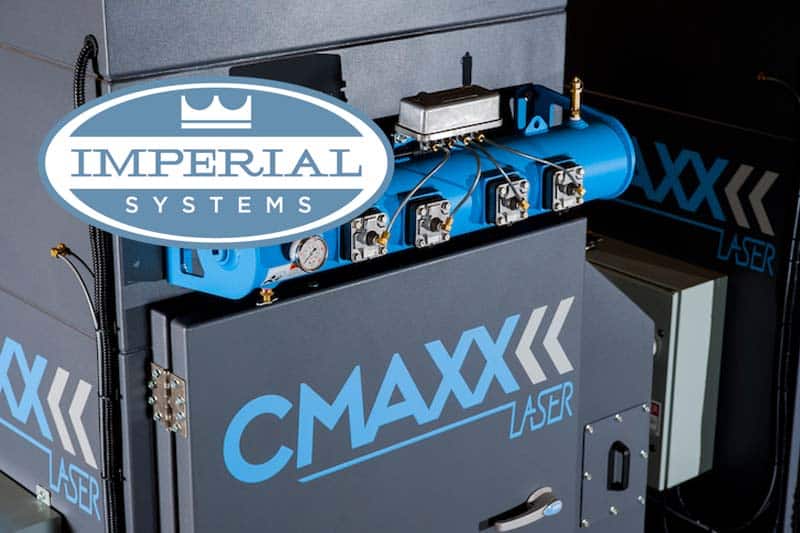
by Imperial Systems | Jul 26, 2016 | Uncategorized
Dust explosions are bad to begin with, but what do you know about secondary explosions? There are many factors that determine how likely a particular type of dust causes deflagration. When you think of combustible dust, do you think of the explosions you’ve heard about at grain handling facilities? Maybe you think of the explosive potential of aluminum dust.
Secondary Dust Explosion Incidents
Three dust explosions occurred in 2003. They demonstrate how many different types of production and manufacturing can produce a deflagration risk, including a secondary dust explosion. In a North Carolina plant, the application of a polyethylene coating to rubber caused accumulation of the dust. As the material dried, dust formed and accumulated above the work area. The work area was clean. But a layer of dust 1/4″ thick was enough to cause an explosion that killed six people. In this situation, a dust collection system in the production area could have captured the dust particles before they circulated through the facility.
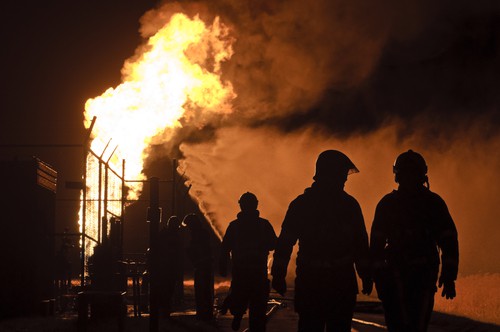 The explosion in Kentucky was caused by combustible dust that resulted from a resin used to treat fiberglass. Workers were aware of the large quantities of dust. But cleaning processes often just caused more of the dust to become airborne. So, it accumulated in the ductwork and in dust collection equipment. There were no safeguards in place to prevent a flame front from traveling through the ductwork or getting into the dust collector. An abort gate with spark or flame detection could have identified and stopped the fire from spreading, and dust collectors designed to stop deflagration fronts could have prevented the dust collectors from becoming sites of secondary explosions.
The explosion in Kentucky was caused by combustible dust that resulted from a resin used to treat fiberglass. Workers were aware of the large quantities of dust. But cleaning processes often just caused more of the dust to become airborne. So, it accumulated in the ductwork and in dust collection equipment. There were no safeguards in place to prevent a flame front from traveling through the ductwork or getting into the dust collector. An abort gate with spark or flame detection could have identified and stopped the fire from spreading, and dust collectors designed to stop deflagration fronts could have prevented the dust collectors from becoming sites of secondary explosions.
Aluminum dust from scrap processing fueled the explosion in Indiana. The dust collector in this case was the source of the explosion. It did not have explosion vent panels, and instead of being directed safely, the explosion traveled back into the building and ignited dust in the ductwork. A secondary explosion occurred when dust accumulated on surfaces inside the facility ignited. A dust collector designed to isolate and redirect a deflagration could have prevented this accident.
NFPA Recommendations
 The National Fire Protection Association, which establishes many of the codes and standards for handling potential fire hazards recommends that all dust collection systems should have explosion venting to redirect explosions and abort gates or other equipment to stop flame fronts from spreading. It also recommends improved housekeeping measures to prevent dust from accumulating. Accomplish this by collecting dust at the source so there’s no accumulation in difficult-to-reach places.
The National Fire Protection Association, which establishes many of the codes and standards for handling potential fire hazards recommends that all dust collection systems should have explosion venting to redirect explosions and abort gates or other equipment to stop flame fronts from spreading. It also recommends improved housekeeping measures to prevent dust from accumulating. Accomplish this by collecting dust at the source so there’s no accumulation in difficult-to-reach places.
It’s often this accumulated dust, hidden on high surfaces, in corners, or inside ductwork, that ignites to cause a secondary explosion that’s far more dangerous than the original one. Witness reports of dust explosions often include descriptions of a smaller explosion followed by one or more larger ones; this is secondary ignition. Dust control throughout the facility, along with fire prevention equipment such as abort gates, spark arrestors, and explosion venting, can control a potential explosion and prevent a small fire from becoming a fatal disaster.
Read more
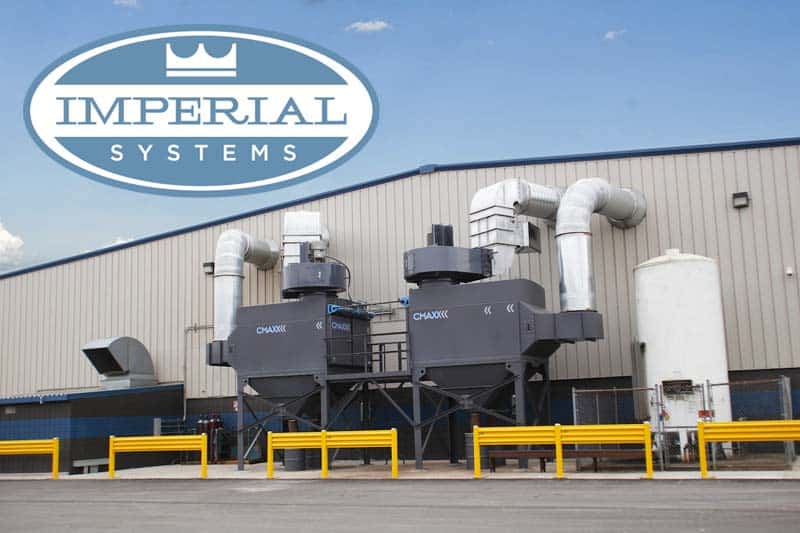
by Imperial Systems | Jul 13, 2016 | Uncategorized
People often use baghouses and dust collectors as synonyms. What is a baghouse? It is a system in which bags made of various materials filter the air. The system periodically cleans the bags to remove accumulated dust.
Today, cartridge dust collectors are increasingly popular in many industries, and for good reason. Cartridge filters can pack a lot of surface area into a small space. They can also filter very small (sub-micron) particulate very efficiently. For some industries, this is essential. This includes metalworking, which generates smoke and fumes that contain potentially toxic materials.
The baghouse, however, has been a workhorse for industrial dust control for many years and continues to serve its role today. While the basic concept remains the same, today they are more adaptable than ever. This is due to new filter materials and new ways to solve problems. Not every industry produces dust that’s fine enough to need the high efficiency of a cartridge collector. The baghouse efficiency is sufficient in plenty of cases.
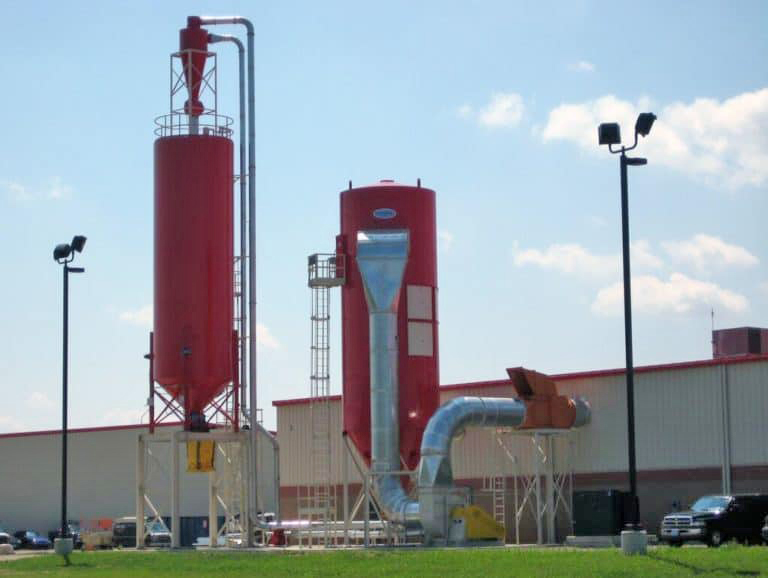 Types of Baghouses
Types of Baghouses
So how does a baghouse dust collector work? Generally, all baghouses have a tube sheet to which the bags attach. They also have an inlet for dirty air and an outlet for clean air. Then there’s an opening at the bottom for collected dust to drop out. The location of these features depends on the type of baghouse. The main differences between types of baghouses are how they clean the bags.
Shaker Baghouses
A shaker baghouse cleans the bags by mechanically shaking them. The bags usually hang from the top of the unit and attach to the tube sheet at the bottom. In this type of system, air typically enters from the bottom. The system pulls the air through to collect dust on the inside of the bags. Clean air then exits at the top while collected dust remains inside the bags.
To clean the bags, the airflow must first be shut off. Then the hanging mechanism shakes the bags to get rid of the dust, which drops out the bottom. These are not the most efficient types of baghouses and can be high-maintenance. Yes, the design is simple and does not require compressed air or complicated supports for the bags. However, damage to the bags can occur from the mechanical shaking mechanism.
Reverse Air Baghouses
In a reverse air filter bag house like our BRF, dirty air enters the collector and dust collects on the outside of the bags, which are supported by a metal cage to keep the air pressure from collapsing them. Steady air circulation continuously pulls air through the filter bags. For cleaning, a fan rotates over the bags, blowing reverse air into them to remove dust.
This type of reverse air baghouse generates a lower pressure than the compressed air pulses of a pulse jet. This decreases wear and tear on the bags and saves on the cost of compressed air. They are usually very cost-efficient and when using within the design parameters, they are also very effective. Also, this type of reverse air baghouse can continue running while cleaning occurs.
An older type of baghouse, also sometimes referred to as reverse air, collects dust on the inside of the bags. Then it cuts off the inflow of dirty air and uses a reverse flow of clean air. This partially collapses the bags, which also removes the dust. These types of bags have rigid rings that allow them to flex but not collapse completely, or “pancake”.
These types of reverse air baghouses have to be taken offline for cleaning. But sometimes they are divided into compartments so one section at a time can be cleaned. So, you can see that the reverse air baghouse working principle can vary from brand to brand.
Pulse Jet Baghouses
A pulse jet baghouse design is somewhat similar. Metal cages support the bags and hang from a tube sheet at the top of the baghouse. Dust and air enter and dust collects on the outside surface of the bags, not the inside. Bursts or pulses of compressed air clean the bags. These travel down the length of the bag and dislodge the dust.
Because the pulse of air travels very quickly down the bags, the baghouse is cleaned without taking it offline. This allows them to operate more efficiently since the system removes dust from the bags at more regular intervals. The downside to the pulse jet bag filter design is the higher pressure and expense of compressed air. These both add to operating costs.
Operation and Maintenance Costs
The EPA provides information (link: https://www3.epa.gov/ttncatc1/dir1/cs6ch1.pdf) to help you make a general calculation of the capital costs of a baghouse dust control system. Their calculations include the cost of the collector, the bags (and cages if necessary), measurement instruments, installation costs, and the annual operating costs (electricity, compressed air, labor, and materials).
These costs will obviously vary widely. A pulse jet baghouse requires compressed air, which other types of baghouses do not need. But it may require fewer filters since they are more efficient.
Filter Replacement
One thing that is a major headache for owners of any type of baghouse: replacing the bags. This is usually a dirty, messy, and time-consuming job. It also requires the collector to be offline for a considerable period of time. It often involves working in an enclosed space. Mechanisms for attaching the bags to the tube sheets vary widely. It can be a very involved process, especially when using cages. Some companies installing new dust control equipment choose a cartridge filter collector. This is because vertical collectors like our CMAXX™ are easy to change and do not involve issues with confined spaces.
For existing baghouses that need frequent bag changes, a pleated filter bag is an option that should be considered. These have a much larger surface area and last much longer than traditional bags, which means less frequent changes. Also, pleated filter bags do not require cages, which greatly simplifies the changing process.
Conclusion
Yes, there’s a lot to know about baghouses! Call us today at 800-918-3013. Our helpful, knowledgeable team members can answer any questions you may have about them. Our goal is to provide the right dust collection solution for your application. Learn more about Imperial Systems’ baghouses.
Read more

by Imperial Systems | Jun 21, 2016 | Uncategorized
Welding Fumes Meet “CSI”: Why Scientists Are Collecting Welders’ Toenails
A group of researchers interested in exposure to metals in welding fumes come to your workplace to collect samples. You might think they’d be there to test the air quality or to take samples of fumes or dust. However, these researchers didn’t come to do any of those things. The only equipment they bring with them: paper envelopes and toenail clippers.
That’s right… these researchers are here for your toenails.
That’s how researchers from the Harvard School of Public Health (Grashow et al, 2014) studied the long-term exposure to toxic metals in weld fumes in a group of welders in Massachusetts. The welders provided several toenail samples over a period of time for analysis of the clippings.
Some forensics television shows have investigators acquire a hair sample and test it for poison. This works because many things that get into our bloodstream, including metals, deposit into our hair and fingernails as they grow. The researchers chose toenails because they grow more slowly and give a record that covers a longer period of exposure.
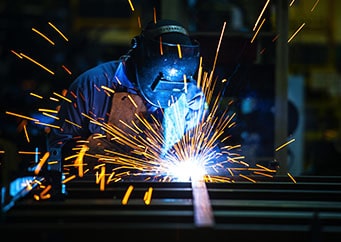
So what did they find?
Even among workers who wore respirators, researchers were able to detect lead, manganese, cadmium, nickel, and arsenic. Lead is a well-known health hazard, and you probably know that arsenic isn’t a good thing either. Long-term exposure to manganese often leads to central nervous system problems that can mimic Parkinson’s disease. Cadmium can cause cancer, and nickel can cause skin problems and lung irritation.
Respirators are a key part of controlling exposure to welding fumes. However, exposure to enough of these metals would reveal their presence in their toenails. While it wasn’t within the scope of this research study to determine exactly how workers were exposed, one possibility is that respirators may be worn while welding, but not while doing other work around the shop in places where dust from cutting and welding may have accumulated.
A dust collection system that removes welding fumes and dust from the air completely will prevent toxic metal particles from accumulating in your work areas. Respirators may prevent inhalation during welding, but if the weld fumes aren’t being removed from the air, workers can still be exposed to it. A system that keeps the air clean for your entire facility doesn’t just protect workers while they’re wearing respirators. It protects all of your workers, all of the time.
Grashow, R. et al (2014). Toenail metal concentration as a biomarker of occupational welding fume exposure. Journal of Occupational and Environmental Hygiene, 11, 397-405.
Read more

by Imperial Systems | Jun 14, 2016 | Uncategorized
Dust collection management is one of the main investments that those in the timber industry must face in the near future. In fact, Timber Processing Magazine (www.timberprocessing.com), which conducts research on industry production, supply, and investments, notes that many facilities will need to plan for additional equipment needs above and beyond those they have already planned for.
Areas where facilities may need to plan for investments include:
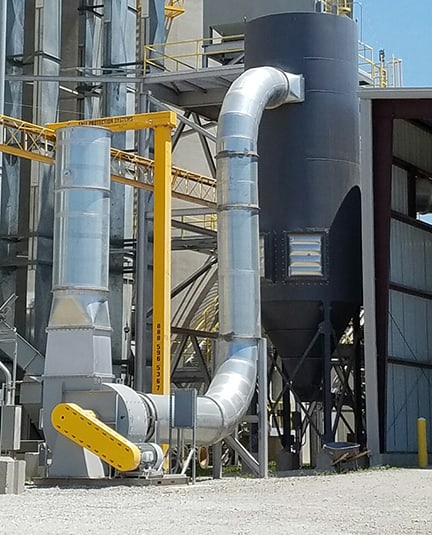
Complete BRF System Installation
- Loading equipment
- Drying kilns
- Planer mill sorting and packaging
- Forklifts
- Conveyors
- Dust control
Because of the highly combustible nature of wood production dust and OSHA’s increasingly strict regulations on combustible dust collection management, dust collection equipment is one of several investments that companies in this industry may need to consider.
Modernization of equipment is often essential to streamline production and materials handling. According to the surveys conducted by Timber Processing Magazine, almost 75% of facilities rated their return on investments in 2015 as “good” or “excellent.”
Investing in Reliability, Safety
When considering where to put that investment, dust control equipment should definitely be top on the list. Processing more product creates more dust, and nothing can shut your production down faster than a malfunctioning dust collection system or, worse, a fire.
Even if your current dust collection system is handling your dust adequately, equipment such as explosion isolation valves, spark arrestors, and backdraft dampers can be a valuable investment in fire and explosion prevention. Wood processing dust has unique demands on dust collection and fire suppression systems, and an experienced systems engineer should be consulted to ensure equipment is optimized for your particular application.
Good news for the timber industry is also good news for manufacturers who produce dust collection management equipment for this industry. This recent report makes it clear that this industry is alive and well, and that companies are likely to see long-term benefits from investments they make in new equipment.
Read more

by Imperial Systems | May 25, 2016 | Uncategorized
Ever wonder how much facilities like yours might be paying when they don’t have proper dust control?
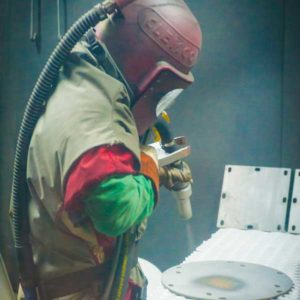
When a facility doesn’t have proper dust control equipment installed, or when they fail to protect their workers from welding fumes or combustible dust, fines from OSHA may be in your future. Since March of 2016, numerous fines OSHA have been handed out for respiratory hazard violations:
- A cement company in Ohio is looking at a $92,000 fine for violations that include silica dust exposure
- A company’s abrasive blasting process without proper air filtration resulted in a $121,000 fine for exposing workers to airborne lead
- Fines for a power equipment manufacturer may total $77,000 for violations including failure to evaluate dust hazards
- A pallet manufacturer is facing $152,000 in fines for safety hazards including combustible dust build-up
- Exposing workers to lead and cadmium dust at seven times the permissible limit will cost a Pennsylvania foundry $42,000
- A minerals company that failed to provide proper air quality and dust control exposed workers to lead and arsenic, which may cost them $106,000
Is your dust collection system ensuring you don’t face these kinds of fines? Imperial Systems can help! Our custom-designed dust control systems will help keep your facility and your employees safe. Call one of our knowledgeable team members today to learn more! 800-918-3013.
Read more

 The explosion in Kentucky was caused by combustible dust that resulted from a resin used to treat fiberglass. Workers were aware of the large quantities of dust. But cleaning processes often just caused more of the dust to become airborne. So, it accumulated in the ductwork and in dust collection equipment. There were no safeguards in place to prevent a flame front from traveling through the ductwork or getting into the dust collector. An abort gate with spark or flame detection could have identified and stopped the fire from spreading, and dust collectors designed to stop deflagration fronts could have prevented the dust collectors from becoming sites of secondary explosions.
The explosion in Kentucky was caused by combustible dust that resulted from a resin used to treat fiberglass. Workers were aware of the large quantities of dust. But cleaning processes often just caused more of the dust to become airborne. So, it accumulated in the ductwork and in dust collection equipment. There were no safeguards in place to prevent a flame front from traveling through the ductwork or getting into the dust collector. An abort gate with spark or flame detection could have identified and stopped the fire from spreading, and dust collectors designed to stop deflagration fronts could have prevented the dust collectors from becoming sites of secondary explosions. The National Fire Protection Association, which establishes many of the codes and standards for handling potential fire hazards recommends that all dust collection systems should have explosion venting to redirect explosions and abort gates or other equipment to stop flame fronts from spreading. It also recommends improved housekeeping measures to prevent dust from accumulating. Accomplish this by collecting dust at the source so there’s no accumulation in difficult-to-reach places.
The National Fire Protection Association, which establishes many of the codes and standards for handling potential fire hazards recommends that all dust collection systems should have explosion venting to redirect explosions and abort gates or other equipment to stop flame fronts from spreading. It also recommends improved housekeeping measures to prevent dust from accumulating. Accomplish this by collecting dust at the source so there’s no accumulation in difficult-to-reach places.
 Types of Baghouses
Types of Baghouses

